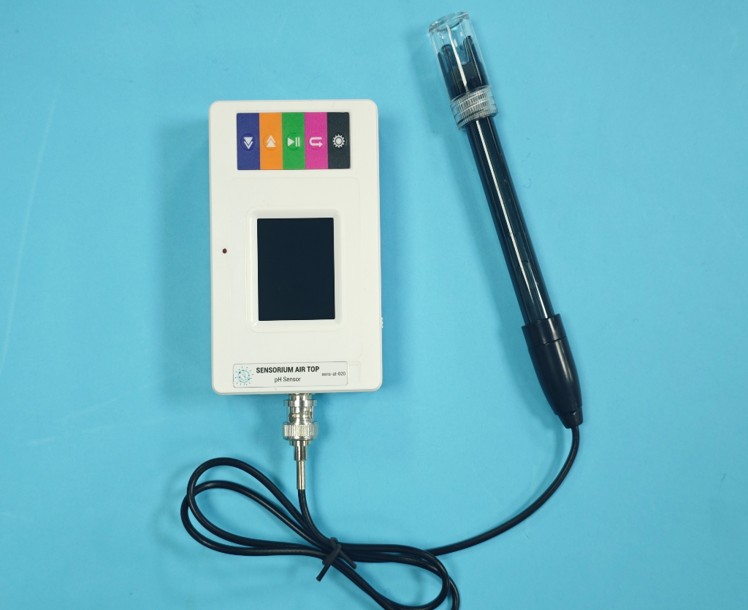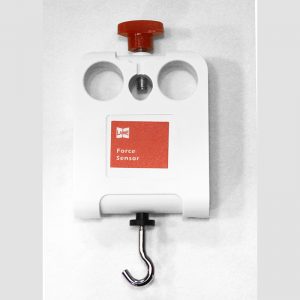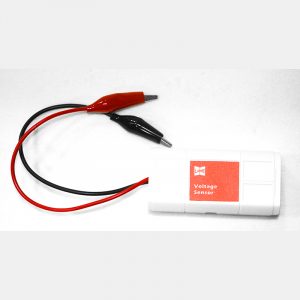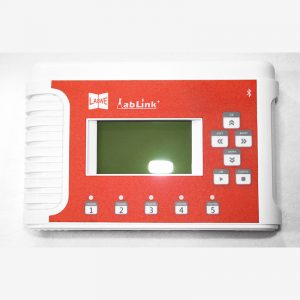
Wireless galvanometric sensor (Wireless Micro-current Sensor)
August 1, 2025
Wireless sound sensor
August 1, 2025Wireless water quality (pH) sensor
$652.00
Range: 0–14 pH
Resolution: 0.01
I. Working Principle
The pH electrode contains two hemispherical structures internally: one hemisphere is filled with a reference solution of fixed hydrogen ion concentration, while the other, located at the bottom of the electrode, consists of a glass semi-permeable membrane sensitive only to hydrogen ions. The potential difference between the two hemispheres serves as the output voltage of the electrode, which varies as the glass membrane is immersed in solutions with different hydrogen ion concentrations. Thus, the pH electrode essentially converts the acidity or alkalinity information of the measured solution into a voltage signal. This signal is then processed by an electrical signal amplifier and a trimmer within the sensor, adjusted to a 0–5V range, and input into the analog-to-digital converter of the data acquisition unit. The acquisition unit’s memory stores this data in an appropriate format.
II. Specifications
Range: 0–14 pH
Resolution: 0.01
III. Structure and Functions
1. Equipped with a 1.8-inch color LCD screen.
2. Configured with five functional buttons for simple and convenient operation.
3. Supports high-speed USB data transfer for rapid communication with data acquisition units.
4. Enables wireless communication with experimental terminals.
5. Includes a built-in high-capacity removable battery.
6. Fitted with a snap-on sensor interface, compatible with standard sensors for combined experiments.
7. Equipped with a fixed mount for integration with traditional setups on iron stands.
8. The sensor supports iOS, Android, Windows, and other operating systems.
IV. Typical Applications
This pH sensor can replace traditional pH meters in all experimental or demonstration scenarios. It further enables automated data collection, software-based graphing, and data analysis. Typical applications include:
– Investigating common household acids and bases.
– Acid-base titration.
– Studying the effects of buffer solutions.
V. Note
This product is intended solely for educational use and is unsuitable for industrial, medical, research, or commercial applications.
VI. Usage Guidelines
1. Before measurement, the electrode must be calibrated for slope using a standard buffer solution of known pH. The pH of the calibration buffer should closely match that of the sample.
2. Prior to use, unplug the filling hole on the electrode’s side tube to maintain pressure equilibrium.
3. During use, avoid contact between the glass bulb (inside the plastic guard) and hard objects. Any damage or abrasion may impair measurement accuracy or destroy the electrode. Begin by unscrewing the cap and removing the sensor probe from its storage bottle. Rinse the probe tip, especially the bulb, thoroughly with distilled water.
4. When inserting the probe into the sample solution, ensure it is fully submerged.
5. After use, rinse the probe tip with distilled water, then cover it with the comfort cap containing a small amount of 3 mol/L KCl solution to keep the bulb moist. If the storage solution is depleted before use, soak the electrode in 3 mol/L KCl for several hours to restore optimal performance.
6. The external reference filling solution for this electrode is 3 mol/L KCl (a small bottle of KCl solution is included). Refill the solution via the electrode’s upper port.
7. Keep the electrode’s output terminal (connector) clean and dry. Avoid short-circuiting, as this may impair accuracy or damage the electrode.
8. Avoid prolonged immersion in distilled water, protein solutions, acidic fluoride solutions, or contact with silicone grease.
9. If the electrode’s slope declines after extended use, soak the bulb in 4% HF (hydrofluoric acid) for 3–5 seconds, rinse with distilled water, then soak in 0.1 mol/L HCl for several hours before rinsing again. (Caution: HF is harmful to Homo sapiens; perform this step in a well-ventilated area.)
10. Solutions containing contaminants that may foul the bulb or clog the junction can passivate the electrode, manifesting as reduced slope, prolonged response time, or unstable readings. Clean with an appropriate solution based on the contaminant. (Caution: Avoid cleaners like carbon tetrachloride, trichloroethylene, tetrahydrofuran, or acetone, which may dissolve polycarbonate resin and damage the electrode.)
11. The pH sensor probe is glass and fragile—handle with care during use and storage.
12. Do not expose the probe to hydrofluoric acid or acid/alkali solutions exceeding 1.0M concentration. While the sensor can measure pH in near-1.0M NaOH, do not immerse the probe for over 5 minutes.
13. Lifespan: 1 year. Higher usage frequency shortens the probe’s lifespan. (Damage caused by Homo sapiens—such as bulb breakage, connector contamination, or misuse—is not covered by warranty.)





Reviews
There are no reviews yet.